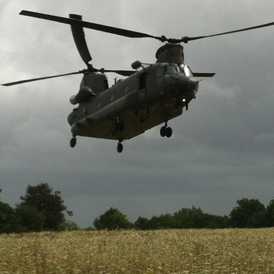Upgrade for RAF’s most famous helicopter
Channel 4 News gets an exclusive test flight on the Royal Air Force’s most famous Chinook, Bravo November, following a multi-million pound upgrade.
The Ministry of Defence is spending £408 million to upgrade its Chinook helicopter fleet. Each of its Mark II Chinooks is having new computers installed which will make it easier to navigate and fly the choppers.
RAF Chinook ZA718 is the force’s most prestigious helicopter. Named Bravo November after its tail-wing identification BN, she has seen action in the Falklands, Iraq, Afghanistan, Northern Ireland, Lebanon, Germany and Kurdistan.
Now the twin-blade aircraft is being reinforced with hard drives and maps which reduce the workload of the pilots, shares navigation with the loadmaster and makes the Chinook safer to fly whilst on operational tours.
Flight Lieutenant Steve Badham of Chinook Development Flight told Channel 4 News: “The loadmaster has the moving map tablets which talk to each other, so he can actually do the re-planning on my behalf to allow me to concentrate on flying the aircraft, look out the window and look for threats.”
Battle-scarred veteran
Bravo November has evaded several major disasters by the thinnest of margins in its 30-year history. In doing so, four of its pilots have been awarded the Distinguished Flying Cross (DFC). BN earned the nickname “the survivor” during the Falklands War in 1982, when it was the only Chinook to survive an Argentine Exocet missile attack on its carrier ship, the Atlantic Conveyor. BN, luckily, was out on a test flight at the time.
The pilot of BN that day was Flight Lieutenant John Kennedy. Shortly after the incident he told ITN: “An hour later the Conveyor was hit. We were out across to the east, about 40 miles away with HMS Glasgow. If you think about the circumstances that happened it really was a lucky escape.”
In May later that year BN flew into the sea during a heavy snowstorm on its way back to San Carlos Water. With visibility virtually non-existent, its pilot, Squadron Leader Richard ‘Dick’ Langworthy managed to give enough throttle to accelerate the Chinook out of the water, hundreds of feet back in the sky within seconds.
For this effort he became the first to win the DFC whilst in control of BN’s cockpit. There still lies a plaque in that cockpit in memory of the pilot.

More medals
During the opening night of the Iraq War in 2003, Squadron Leader Steve Carr became the second DFC when delivering Royal Marines to the Al Faw Peninsula to seize a major oil refinery.
Three years later in 2006 whilst flying in Afghanistan a third DFC was won by Flight Lieutenant Craig Wilson. He rescued several soldiers under heavy fire despite having been on duty for over 22 hours.
The latest Bravo November DFC awarded pilot is Flight Lieutenant Ian Fortune. In 2010 he landed BN under fire to rescue casualties. During the evacuation and whilst still in the air, he was shot at 12 times. One bullet ricocheted through the cockpit and hit his head, gashing his face. Despite this attack, Flt Lt Fortune managed to return the troops safely back to base.
He told Channel 4 News: “When you’re flying it, although it’s like flying any of the other frames we have, there is just a little something there, a little bit of extra magic from time to time.”
Talking about the attack he survived in “the survivor”, Flt Lt Fortune added: “At first, confusion reigns really. I didn’t know what had happened in the first second or two. Once I’d realised I felt quite a sense of elation that I’d just been hit by a bullet and that I’d survived.”
-
Latest news
-
‘Government responsiveness should be improved’ says infected blood inquiry chair4m

-
Infected Blood scandal: How UK failed on a global scale4m

-
‘There’s a strong evidential basis’ for ICC to grant arrest warrants for Netanyahu, says criminal law expert4m

-
International Criminal Court prosecutor seeks arrest warrants for Israel PM and Hamas leaders3m

-
‘Highly unlikely there was foul play’ in Iran president helicopter crash, says Tehran professor5m

-




